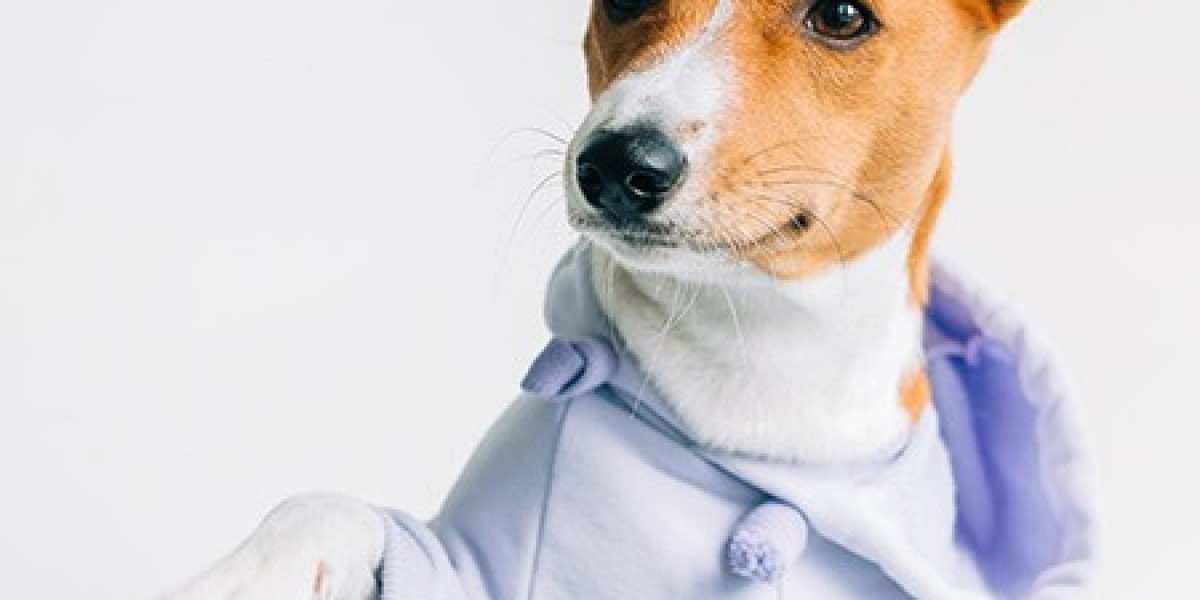Dogs have a natural tendency to lick or bite their wounds. While this is often an instinctive behavior aimed at soothing discomfort, it can slow healing or lead to infections. Many pet owners search for alternatives to traditional Elizabethan collars (the dreaded “cone of shame”) to keep their pets safe and comfortable during recovery. One solution gaining popularity is the use of dog clothes. But can clothing really help stop a dog from licking or biting at wounds? Let’s explore this topic in detail.
Why Do Dogs Lick or Bite Their Wounds?
Dogs rely heavily on their instincts, and licking wounds is a natural behavior they’ve carried for centuries. Understanding why they do this is the first step toward controlling it.
Instinctual Healing Behavior
Dogs lick wounds because their saliva contains mild antibacterial properties. For them, it’s a way to clean the wound. This instinct worked well in the wild but can create more problems in modern veterinary care where precise wound management is required.
Coping With Pain and Irritation
Licking can also be a response to discomfort. Wounds itch as they heal, and your dog may feel relief by licking or biting. However, excessive licking can reopen stitches or spread bacteria.
Anxiety and Stress
Sometimes licking and biting aren’t just about the wound itself. Stress or anxiety can amplify these behaviors. For example, a nervous dog might obsessively lick at an injury as a way of self-soothing.
The Role of Dog Clothes in Wound Protection
When most people think of dog clothes, they picture cute sweaters, jackets, or costumes. But clothing also has functional benefits, especially when it comes to wound care.
Physical Barrier
Clothes create a protective barrier between the wound and the dog’s tongue or teeth. Unlike cones, which restrict head movement, clothing covers the wound directly. For injuries on the torso, back, or legs, clothes can prevent easy access.
Reduced Stress Compared to Cones
The Elizabethan collar is effective, but many dogs find it uncomfortable. It can make eating, drinking, or sleeping difficult. Soft recovery suits or specially designed dog clothes can reduce stress by offering freedom of movement without constant obstruction.
Coverage for Specific Body Parts
Not all wounds are in the same location. Clothing can be tailored or chosen to cover particular areas:
Bodysuits for torso wounds.
Sleeves for leg injuries.
Lightweight shirts for chest or belly incisions.
This customization makes clothing a versatile option for wound protection.
Types of Dog Clothes for Wound Management
Not all dog clothes serve the same purpose. Let’s look at different options and their uses in protecting wounds.
Recovery Suits
Recovery suits are designed specifically for pets recovering from surgery. They are snug, full-body garments that cover wounds and surgical stitches. They prevent licking while still allowing the dog to move comfortably.
Dog Shirts or T-Shirts
A simple dog shirt can cover wounds on the torso or upper limbs. Many owners repurpose baby clothes as an affordable option. The soft cotton material is breathable and gentle on the skin.
Dog Pajamas
For larger wound coverage, pajamas can act as an effective barrier. They are particularly useful in colder climates where warmth is also beneficial.
Protective Leg Sleeves
Some companies create leg sleeves that work like compression wear. These are great for localized wounds on the legs, especially those caused by hot spots or post-surgical stitches.
Pros and Cons of Using Dog Clothes for Wound Protection
While dog clothes can be useful, they aren’t perfect for every situation. Understanding the benefits and limitations will help you make the right choice for your pet.
Advantages
Comfortable alternative to cones.
Allows freedom of movement.
Prevents direct access to wounds.
Helps reduce stress and anxiety.
Provides warmth and comfort during recovery.
Disadvantages
Not suitable for wounds on the face or head.
Some dogs may chew or tear the fabric.
Needs frequent washing to prevent bacteria buildup.
May cause overheating in warm climates.
Comparing Dog Clothes to Other Methods
There are multiple ways to prevent dogs from licking or biting wounds. How do dog clothes stack up against these alternatives?
Elizabethan Collars
Effectiveness: High, but uncomfortable.
Drawback: Restricts mobility and can cause stress.
Comparison: Clothes provide more comfort but may be less effective for face or paw wounds.
Inflatable Collars
Effectiveness: Moderate, allows some comfort.
Drawback: May still allow access to certain areas.
Comparison: Clothes cover wounds directly, offering better localized protection.
Bandages
Effectiveness: Good for small wounds but can come loose.
Drawback: Dogs often chew them off.
Comparison: Clothes provide more comprehensive coverage without constant reapplication.
How to Choose the Right Dog Clothes for Wound Protection
Selecting the right garment can make a big difference in how well it works. Here are key factors to consider.
Material and Comfort
Look for breathable, soft fabrics like cotton. Avoid wool or rough materials that may irritate the wound.
Fit and Size
A snug fit ensures that your dog cannot easily slip out of the clothes. However, it should not be too tight, as this can restrict movement and circulation.
Accessibility for Cleaning
Choose clothes that allow easy access to the wound for cleaning and medication. Some recovery suits have snap buttons or zippers for convenience.
Durability and Washability
The clothes should be washable and durable enough to withstand scratching, chewing, and regular use.
How to Train Your Dog to Accept Dog Clothes
Not all dogs will take to dog clothes immediately. Training and patience are key.
Introduce Clothing Gradually
Start with short sessions of wearing the clothes. Reward your dog with treats and praise.
Positive Association
Use playtime or offer cat toys or dog toys as distractions when they’re wearing clothes. This makes the experience enjoyable rather than stressful.
Monitor Comfort
Watch for signs of irritation such as scratching, restlessness, or chewing at the clothes. Adjust or try different clothing styles if needed.
Practical Tips for Using Dog Clothes to Prevent Wound Licking
To make the most of dog clothes during recovery, follow these practical tips:
Keep Clothes Clean
Wash them regularly to prevent bacteria from accumulating. Dirty clothes can make wounds worse instead of better.
Monitor the Wound Daily
Even with clothing, check the wound daily for signs of infection such as redness, swelling, or discharge.
Combine With Other Methods
For stubborn dogs, combining clothes with mild bandages or an inflatable collar can provide extra protection.
Case Examples: When Dog Clothes Work Best
Post-Surgical Recovery
After procedures like spaying or neutering, a recovery suit can keep your dog from reaching the stitches, promoting faster healing.
Hot Spots or Skin Allergies
Clothing can stop your dog from licking or biting itchy patches, giving the skin a chance to heal while you apply topical treatments.
Seasonal Allergies
Some dogs develop skin wounds due to allergies. Dog clothes act as a shield against pollen, grass, or dust, minimizing irritation.
Common Mistakes to Avoid
While dog clothes are effective, misusing them can create problems.
Leaving Clothes on Too Long
Dogs need breaks to let their skin breathe. Constant wear without rest can cause rashes or overheating.
Ignoring Fit Issues
Loose clothing can be chewed off, while overly tight garments can cause discomfort or circulation issues.
Neglecting Hygiene
Clothes should be washed regularly. Unwashed garments can harbor bacteria that worsen wounds.
Beyond Wound Care: Other Benefits of Dog Clothes
Aside from wound protection, clothing offers several other benefits for dogs.
Weather Protection
In colder climates, dog clothes keep pets warm. In warmer climates, lightweight UV-protective clothing can shield them from sunburn.
Anxiety Relief
Snug-fitting clothes can have a calming effect, similar to weighted blankets for humans. This is especially helpful during thunderstorms or fireworks.
Style and Fun
While functionality is the main focus, many owners enjoy dressing up their pets for fun. Matching outfits with dog clothes and cat toys in themed photoshoots can add joy to the pet-parent relationship.
What About Cats?
While this blog focuses on dogs, some principles apply to cats as well. Cats also lick wounds excessively, especially after surgeries. Lightweight recovery suits or shirts can work for felines, though cats may resist more strongly than dogs. Using cat toys as a distraction can help in training cats to accept clothing.
Final Thoughts
So, can dog clothes help prevent licking or biting wounds? The answer is yes—when used correctly. They offer a comfortable and practical alternative to cones, providing direct coverage and reducing stress for pets during recovery. However, they are not foolproof. The effectiveness depends on the wound’s location, the type of clothing, and how well the garment fits your pet.
As a pet parent, you must monitor your dog’s comfort, maintain hygiene, and choose the right garment for the situation. Combined with regular veterinary care and observation, dog clothes can be a valuable tool in promoting safe and speedy recovery.
And while the primary goal is healing, don’t forget that clothing can also bring warmth, style, and fun to your pet’s life. Pairing functional clothing with engaging cat toys or dog toys can make recovery not just manageable, but enjoyable.








